Algae
Algae issue is something that we can’t avoid but we can do our best to minimized the damage. In a planted aquarium, an even more complex set of variables can easily go out of whack, and it might just end up a totally green tank.
There are 3 common types of algae that require external
chemical treatment to reduce its problem. These algae are the ones that will
not be able to be “cleaned up” by the fishes and shrimps in the tank.
1. Blue Green Algae (Cyanobacteria)
2. Black Brush Algae
3. Hair Algae
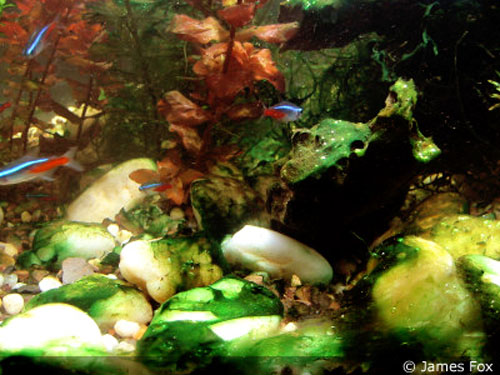
1. Blue Green Algae (BGA)
While often referred to by aquarists as an algae, Blue Green Algae (BGA) is in fact a bacterial slime that can easily coat everything in your tank. Appearing as either a green, black, or purple coating, BGA is perhaps best known for the unique earthy smell that it has when pulled from the tank. As a nitrogen-fixing bacteria, it will fully deplete your water column of any available nitrogen.
Causes:
Low nitrates – Usually present when all of the nitrogen/nitrate has been removed from the water column. While this is a triggering condition, it is also exacerbated by the bacteria itself using any remaining nitrogen.
High organics – Overfeeding, or excess organic matter in the tank can trigger BGA.
Old light bulbs – Sometimes present when light bulbs are no longer emitting usable light. This may be more of a matter of your plants no longer being able to out-compete the bacteria.
Poor water circulation – Circulation is key in a planted aquarium so that no “dead spots” are present where nutrients have been used up locally, but fresh ones are not being recirculated throughout.
Cures:
Increase nitrates – Dose nitrates until the concentration reaches ~5ppm.
Add fast growing plants – this helps to out-compete the algae for resources.
Blackout – BGA cannot survive without light.
Excel/H202 treatment – Use a syringe to spot treat problem areas. Then manually remove dead patches.
Erythromycin – use antibiotics at half dosage to kill the bacteria. Mardel Labs’ Maracyn contains erythromycin and has been used effectively without harming most plants.
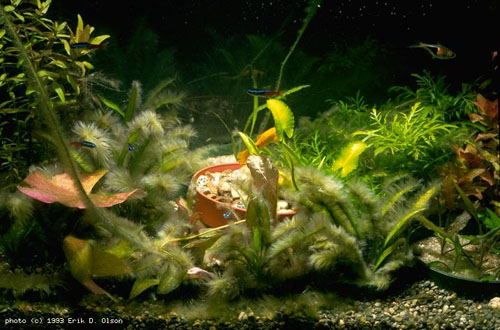
Black Brush Algae
Black Brush Algae, or BBA, is one of a member of the specific genera of “red” algae in the Rhodophyta family. Most of the algae in this family are marine based, but some have adapted to freshwater conditions that particularly target our beautifully planted aquariums. These algae may be black, brown, red, or green in coloration, and can quickly coat your plants and hardscape if not controlled properly.
The Black Brush Algae has a photosynthesizing auxiliary pigment called phycoerythrin which absorb blue light and reflect red. Therefre, BBA is usually black to purplish-gray in colour instead of green like other algae. It forms short hairs (1/4″ long) that grows closely packed together. It grows on slow growing plants and solid surfaces such as decoration and substrate. When growing on plants, in usually grow around the edges of the leaves.
Causes:
1. Nutrient Imbalance – potentially excess of Nitrogen (N), Phosphorus (P), and Iron (Fe).
One should strive for the following nutrient levels to reduce the possibility of BBA occuring:
- Nitrogen (10-20ppm)
- Phosphorus (0.5-2ppm)
- Potassium (10-20ppm)
- Calcium (10-30ppm)
- Magneisum (2-5ppm)
- Iron (.1ppm)
2. Low pH – Neil Frank observes that African Rift tanks never have BBA. It’s believed that BBA thrives in acidic environments, which is unfortunately what most plants prefer.
3. Excess lighting which speeds up the growth and spread of BBA
4. Unstable and too low carbon dioxide levels
Cure:
1. Increase CO2 – This will stimulate plant growth, which should help the plants out-compete the algae for resources.
2. Excel/Hydrogen Peroxide (H202 treatment) – Use a syringe to spot treat problematic areas. Then manually remove when BBA turns grey/white.
3. Manual removal – Use toothbrush to remove as much as possible.
4. Bleach treatment – Dip affected hardscape items/hardy plants in a bleach/water solution using a 1:20 ratio of bleach to water. Before putting them back into the tank, make sure the item is free of bleach odor.
5. OxiClean treatment – Dip affected hardscape items in a OxiClean solution, making sure you only use the original OxiClean with no other additives.
6. Maintain proper water change/dosing schedule – weekly / bi-weekly changes.
7. Algae Crew – Siamese Algae Eaters (SAE), American Flag Fish, and Amano shrimps are known to eat this algae.
8. Copper (not recommended) – There are commercial algaecides containing copper that will kill BBA, but they will mostly likely also kill your plants.
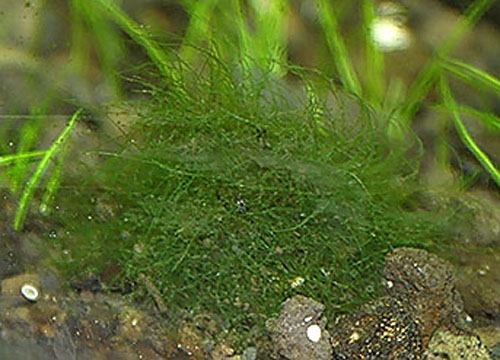
Cladophora is by far the toughest algae to remove from the aquarium. Forming green, tough, wool-like mats, it seems to favor intermingling itself into hairgrass, substrate, and hardscape items.
Causes:
Marimo Balls – Being in the same family as these algae balls, they can sometimes introduce Cladophora to your aquarium.
Healthy Conditions – Unfortunately, Cladophora seems to favor the same healthy water conditions that your plants require.
Cure:
Manual removal – Use toothbrush/tweezers to remove as much as possible.
Excel/H202 treatment – Use a syringe to spot treat problem areas.
Luck – Very difficult to 100% remove.
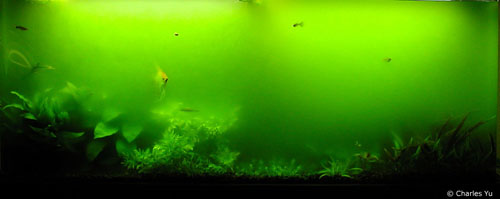
Green water is free floating single-celled euglenoid protists. It contains chlorophyll a and b, plus carotenoids, giving them their green coloration, but they are not plants. With over 40 genera of Euglenoids and over 1000 species, this form of algae is one of the most abundant forms of life on the planet, and is an essential part of the food chain. Unfortunately, aquarists don’t want it in their tanks.
Cause:
Initial Setup – Usually present shortly after an aquarium is initially setup, prior to the full establishment of the microorganisms (free-swimming plankton that feed upon it).
Nutrient Imbalance – Strive for the following nutrient levels: N (10-20ppm), P (0.5-2ppm), K (10-20ppm), Ca (10-30ppm), Mg (2-5ppm), Fe (.1ppm).
Medication – if the medicine affects the biofilter of the tank.
Cause:
Initial Setup – Usually present shortly after an aquarium is initially setup, prior to the full establishment of the microorganisms (free-swimming plankton that feed upon it).
Nutrient Imbalance – Strive for the following nutrient levels: N (10-20ppm), P (0.5-2ppm), K (10-20ppm), Ca (10-30ppm), Mg (2-5ppm), Fe (.1ppm).
Medication – if the medicine affects the biofilter of the tank.

Brown Algae, or diatoms, often present themselves as a brown, muddy, muck that covers plant leaves and hardscape items. It is rare to be seen in a fully established aquarium.
Causes:
Newly
setup tank – Aquariums that have just been setup seem to be prone to
diatom algae.
Excess
nutrients – Silica in particular appears to be a trigger. Contact your
water utility company for a report detailing silica concentrations in your
water supply.
Possibly old bulbs – Sometimes, old bulbs can encourage the conditions for diatom algae.
Cure:
Time
– Allow it to use up the excess silica, and it will often disappear on its
own.
Manual
removal – Siphon/scrape diatoms manually for quick removal.
Algae Crew – Otocinclus and Nerite snails are fantastic at clearing a tank of diatoms. They help with other sorts of algae as well.

Green spot algae is very commonly seen on the glass of tanks when there hasn’t been a water change in awhile, or when an inadequate fertilization scheme has been conducted. GSA also appears on long lasting leaves, such as Java Fern, Anubias, and Bolbitus.
Cause:
Low phosphate (PO4) levels – almost exclusively caused when phosphate levels are depleted.
Cure:
Scrap glass – Use a razor blade to most easily remove from the glass.
Dose Phosphates – Dose PO4 to a concentration of 0.5-2.0ppm.
Nerite Snails – Nerite snails can help you remove green spot from leaves, as well as, the glass.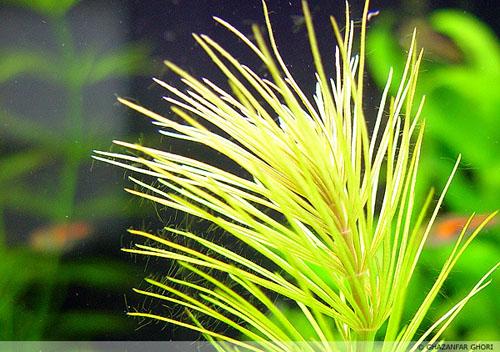
Fuzz algae often shows up on plant leaves giving their edges a slightly fuzzy appearance.
Causes:
Nutrient Imbalance – Strive for the following nutrient levels: N (10-20ppm), P (0.5-2ppm), K (10-20ppm), Ca (10-30ppm), Mg (2-5ppm), Fe (.1ppm).
Low CO2 – Strive for 20-30ppm concentration of CO2, as permitted by fauna.
Cure:
Maintain proper nutrient/CO2 levels
Algae Crew – Siamese Algae Eaters (SAE), Amano shrimp, Otocinclus, and Mollys are known to eat this algae.